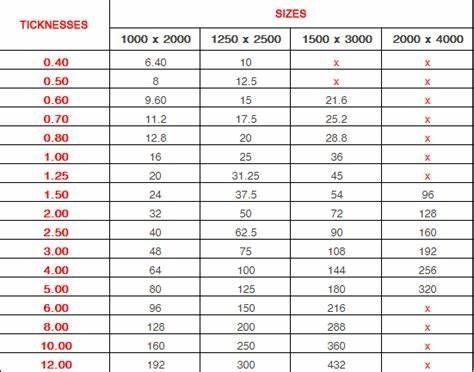You can find the common used aluminum specification in the aluminum sheet thickness chart. Aluminum sheet thickness is an important parameter of aluminium sheets, and different thicknesses are suitable for different application scenarios. The thickness of aluminum sheet metal is usually measured in millimeters (mm), gauge, inch and can be divided into several categories based on the thickness. Below are some common aluminum sheet thickness categories and their corresponding ranges:
Thin aluminum sheet: thickness between 0.15 and 2.0mm.
Regular thick aluminum sheet: thickness between 2.0 and 6.0mm.
Medium thick aluminum sheet: thickness between 6.0~25.0mm.
Thick aluminum sheet: thickness between 25~200mm.
Super thick aluminum plate: thickness over 200mm.
Please note that these aluminum sheet thickness chart are not absolute and may vary from standard to standard and industry to industry. Meanwhile, the application of aluminum sheet also determines the choice of thickness, such as construction, aerospace, automotive manufacturing and other fields have different requirements for aluminum sheet thickness.

Common aluminum sheet thicknesses include 0.5mm, 1.0mm, 2mm, 3mm, 4mm, 5mm, 6mm, 8mm, 10mm, and more, but specific thicknesses can be customized for specific needs.
1mm aluminum sheet:
Thin and lightweight, suitable for applications requiring light weight and space saving.
Good processing performance, easy to cut, bend and weld.
Commonly used for decorative panels, electrical appliance housings, small structural parts, etc.
3mm aluminum sheet:
Thicker and stronger than 1mm aluminum sheet.
Suitable for occasions that require a certain load-bearing capacity, such as billboards, display racks and so on.
Processing performance is still good, can meet a variety of processing needs.
5mm aluminum sheet:
Strength is further improved, suitable for occasions with certain requirements on strength.
It can be used for building exterior decoration, vehicle shells, industrial equipment and so on.
When processing, attention needs to be paid to the selection of appropriate processes and equipment to ensure the quality of processing.
6mm aluminum sheet:
Similar to 5 mm aluminum sheet, but slightly thicker, may have better bending and impact resistance.
It is suitable for occasions requiring high strength, such as large billboards and shipbuilding.
8mm aluminum sheet:
Thicker, with higher strength and stability.
Commonly used in large building curtain walls, bridge decoration, heavy equipment shells, etc.
Special attention needs to be paid to controlling deformation and ensuring precision during processing.
10 mm aluminum sheet:
It is the thickest among these thicknesses, with excellent load-bearing capacity and stability.
It is suitable for occasions with very high requirements for strength, such as heavy machinery, large structural components, etc..
Processing is relatively difficult and requires specialized equipment and processes.
When choosing from the aluminum sheet thickness chart, in addition to considering factors such as strength and processing performance, you also need to consider other factors such as cost, weight and corrosion resistance. At the same time, different application scenarios and uses may also have special requirements for the alloy composition and surface treatment of aluminum sheets.
live:onlinehcx